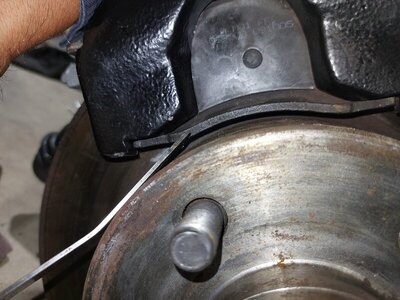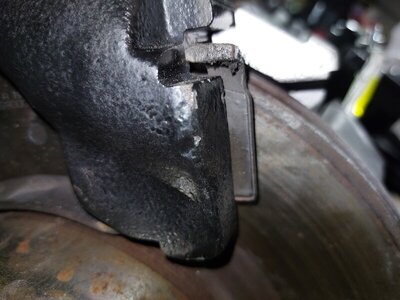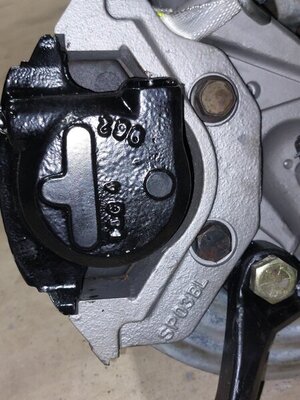You are using an out of date browser. It may not display this or other websites correctly.
You should upgrade or use an alternative browser.
You should upgrade or use an alternative browser.
Caliper rubbing rotor
- Thread starter aussiewannabee69
- Start date
This is from the factory service manual. Anyone doing brake work should know this. The pad should fit tight with zero movement.
(1) Slide new outboard shoe and lining assembly in
recess of caliper. CAUTION: No free play between
brake shoe flanges and caliper fingers (Fig. 10)
should exist (which might cause brake shoe rattle). If
free play is evident by vertical shoe movement after
installation, remove shoe from caliper and bend
flanges (Fig. 11) to create slight interference fit to
eliminate all vertical free play when shoe is installed.
Install shoe after above modification, if necessary, by
snapping shoe into place with fingers or with light
"C" clamp, protect new lining from damage or contamination
by using old pads over new lining and
across caliper fingers (Fig. 12).
(1) Slide new outboard shoe and lining assembly in
recess of caliper. CAUTION: No free play between
brake shoe flanges and caliper fingers (Fig. 10)
should exist (which might cause brake shoe rattle). If
free play is evident by vertical shoe movement after
installation, remove shoe from caliper and bend
flanges (Fig. 11) to create slight interference fit to
eliminate all vertical free play when shoe is installed.
Install shoe after above modification, if necessary, by
snapping shoe into place with fingers or with light
"C" clamp, protect new lining from damage or contamination
by using old pads over new lining and
across caliper fingers (Fig. 12).
aussiewannabee69
Well-Known Member
10.94What size are the rotors 10.94 or 12”?
aussiewannabee69
Well-Known Member
Yes this was the problem. I wasn't aware that the tabs had to be bent. You can see how much gap I have if the tab is bent correctly. Awesome. Thanks very much.Its the pad its to loose and dropping down. Bend the tabs and it will pull the pad up. The fix is plain as day. Blow the picture up. The green circles show how much of a gap there is. That end the pad is shown sitting higher. The tab still needs to be bent to keep the pad up. The opposite end the tab is hitting but the pad is hanging down. That is allowing the pad to rub the rotor. I always bend the tabs so the pad needs to be lightly tapped into the caliper for proper seating. Both people have the same problem. Parts are correct. I could have both fixed in less time than it took me to type this. Blow up the pictures and you can clearly see the problems.


Glad it worked out for you. Simple fix.Yes this was the problem. I wasn't aware that the tabs had to be bent. You can see how much gap I have if the tab is bent correctly. Awesome. Thanks very much.
View attachment 1214198 View attachment 1214199
MIKESPOLARA
Well-Known Member
Glad it worked out for you. Simple fix.
Loose pad also causes noisy brakes. The squeal you hear at times is the metal back of the pad rubbing against the caliper body.
Chevy disc brakes from the 60's/70's have the same style "fingers" that need to be bent down for a snug pad fitment
aussiewannabee69
Well-Known Member
MoparLeo has a good eye. I am not an expert on this, but there is a common brake conversion done on these cars to convert to 1973+ brake rotors, 73+ A-body spindles. Some of the conversions are done using Cordoba rotors and caliper brackets. "Maybe" the previous owner started to do one of those conversions and got mixed up on exactly which parts to use? Or they simply got the wrong parts and put them on?
As I mentioned, I'm not an expert on this, but I did one of those swaps on my 1970 car and your rotors kinda look like my 73+ rotors. So....maybe check for any numbers you can find on the calipers, rotors, caliper brackets and spindles and let us know. (larger pictures would help too). There are many number experts on here that can figure this out for you. Maybe also check the other side and see which parts are different?
Seems like all the parts are on the correct side. The caliper mount are SPL03L on the left. And r on the right.

MoparLeo
NRA BENEFACTOR LEVEL LIFE MEMBER
- Local time
- 12:54 PM
- Joined
- Nov 24, 2015
- Messages
- 2,499
- Reaction score
- 2,722
- Location
- Moreno Valley, So California
The bracket does not indicate front or rear mount only left or right. It could be mounted to the front or rear and still be the left side.
The factory mounted the calipers to the front side of the knuckle/spindle. They can be relocated to the rear if needed for sway bar clearance on some years. A different brake hose is required when you change the mount location as the length will be different.
The factory mounted the calipers to the front side of the knuckle/spindle. They can be relocated to the rear if needed for sway bar clearance on some years. A different brake hose is required when you change the mount location as the length will be different.
Similar threads
- Replies
- 6
- Views
- 843
- Replies
- 16
- Views
- 782
- Replies
- 10
- Views
- 635
- Replies
- 2
- Views
- 584
- Replies
- 22
- Views
- 2K
















